
About UsThe Numismatic Bibliomania Society is a non-profit organization promoting numismatic literature. For more information please see our web site at coinbooks.org SubscriptionsThose wishing to become new E-Sylum subscribers (or wishing to Unsubscribe) can go to the following web page link MembershipThere is a membership application available on the web site Membership Application To join, print the application and return it with your check to the address printed on the application. Membership is only $15 to addresses in the U.S., $20 for First Class mail, and $25 elsewhere. For those without web access, write to: David M. Sundman, Secretary/TreasurerNumismatic Bibliomania
Society AsylumFor Asylum mailing address changes and other membership questions, contact David at this email address: dsundman@LittletonCoin.com SubmissionsTo submit items for publication in The E-Sylum, just Reply to this message, or write to the Editor at this address: whomren@coinlibrary.com
BUY THE BOOK BEFORE THE COINYou won't regret it! |
- WAYNE'S WORDS: THE E-SYLUM APRIL 8, 2012
- SKOW MAIL BID SALE #16 CLOSES JUNE 2, 2012
- BENEZIT INTERNATIONAL ARTIST DIRECTORY NOW ONLINE
- BOOK REVIEW: A GUIDE BOOK OF CANADIAN COINS AND TOKENS
- FARE BOX EDITOR DR. JOHN COFFEE SIDELINED BY INJURY
- APRIL FOOLS 2012
- ELECTROTYPE PORTRAIT IDENTIFICATIONS
- QUERY: AGING A PERSON'S PHOTO TO HELP WITH ATTRIBUTION
- MORE ON THE SMITHSONIAN'S LINCOLN MEDAL
- MORE ON THE PROPOSED U.S MINT AT THE DALLES, OREGON
- COLONEL GREEN AND THE INVERTED JENNY
- MORE ON THE SCHULMAN MEDALLIC HISTORY OF MONEY AND BANKING
- 2012 MEMPHIS INTERNATIONAL PAPER MONEY SHOW SPEAKERS
- ANA MUSEUM SHOWCASE IN DENVER FEATURES AUDIO TOURS
- WOMEN AT THE U.S MINT AND BEP
- NOTES FROM E-SYLUM READERS: APRIL 8, 2012
- THE COLORADO SPRINGS COIN CLUB 50TH ANNIVERSARY MEDAL
- SCREW ALASKA WITH WOODEN RADICALS
- GILROY ROBERTS EXHIBIT TO OPEN AT THIRD PHILADELPHIA MINT
- RECONSTITUTING THE EAST INDIA COMPANY
- PINEDA COLLECTION OF PHILIPPINE COINS AND PAPER MONEY
- THE ROYAL CANADIAN MINT MINTCHIP CHALLENGE
- THE DEATH OF BOOKS
- FEATURED WEB PAGE: QUEEN HANDS OUT MAUNDY MONEY
WAYNE'S WORDS: THE E-SYLUM APRIL 8, 2012

There were no new subscribers this week. We have 1,526 email subscribers, plus 174 followers on Facebook.
This week we open with an update from David Sklow, word from Dick Johnson on a great online resource for numismatic researchers, and a review of the new Haxby guide on Canadian Coins and Tokens.
Other topics include: Dr. John Coffee, The Dalles, Women at the U.S. Mint and BEP. To learn more about April Fools, coins made of Titanium Nitride Plated Inox, and Col. Green and the Inverted Jennys, read on. Have a great week, everyone!
Wayne Homren
(whomren@gmail.com)
Numismatic Bibliomania Society
SKOW MAIL BID SALE #16 CLOSES JUNE 2, 2012
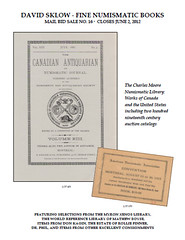 DAVID SKLOW - FINE NUMISMATIC BOOKS
DAVID SKLOW - FINE NUMISMATIC BOOKS
MAIL BID SALE NO. 16 CLOSES JUNE 2, 2012
THE CHARLES MOORE LIBRARY
WORKS ON CANADIAN AND U. S. NUMISMATICS
The Moore Library offers bidders a rare opportunity to purchase some items of great rarity as well as items that have not been offered in many years: Complete sets of The Canadian Bankers' Association Journal, The Canadian Antiquarian and Numismatic Journal, The Canadian Numismatic Journal, The C. N. A. "Bulletin"; also many rare works of Robert Wallace McLachlan, Jos. LeRoux and P. N. Breton, over one hundred nineteenth and early twentieth century auction catalogs with high ratings by Adams for their Canadian content; and more.
The sale also features important selections from the library of Myron Xenos including super deluxe edition of Browning by Breen; super deluxe leather album "The Invasion of Louisville"; the Chapman brothers Frossard bid books; three deluxe editions of works by David Lange all serial number one; and more notable consignments.
Bids may enter bids by mail, telephone, email or fax. The sale closes at 8pm mountain time, June 2, 2012. Note, any bids left on our answering machine or sent by email or fax on or before midnight will be accepted. View our catalog on-line: www.finenumismaticbooks.com or request a hard copy at no charge.
David Sklow-Fine Numismatic Books
P.O. Box 6321
Colorado Springs, CO 80934
PH: 719-302-5686
FAX: 719-302-4933
EMAIL: numismaticbooks@aol.com
WEB: FineNumismaticBooks.com
BENEZIT INTERNATIONAL ARTIST DIRECTORY NOW ONLINE
 Oxford University Press has just acquired the rights to place the English language edition of the full 14 volumes of Benezit online. Benezit is the French directory of international artists now covering biographical data on 170,000 world artists. First published in 1911 it has progressed through eight editions, from 3,000 pages in early editions to 20,608 pages in the latest printed format, first offered in English in 2006.
Oxford University Press has just acquired the rights to place the English language edition of the full 14 volumes of Benezit online. Benezit is the French directory of international artists now covering biographical data on 170,000 world artists. First published in 1911 it has progressed through eight editions, from 3,000 pages in early editions to 20,608 pages in the latest printed format, first offered in English in 2006.
Oxford has merged Benezit artist biographical information with the 34-volume Grove Art Dictionary, with illustrations and listings of artists' work with references to published articles and other data for more in-depth information and where to obtain even more. Oxford acquired Grove Art in 2003.
This massive art reference information resource can now be accessed with an Oxford subscription for individuals of $195 per year (or $19.95 per month). Or perhaps visit your nearby college or large city library where they might have an institution subscription allowing researchers free access. More info at oxfordindex.oup.com
I was enamored with Benezit for the last ten years as I was (still am) compiling a directory of American Artists of Coins and Medals. I acquired my printed set of Benezit in 2007 after I learned the English version had only become available in 2006. I reported on this in The E-Sylum (December 2, 2007; Vol 10, No 49, Art 9). I turned over every page of those 14 volumes searching for the 3,356 artists I knew made American coins and medals (took me six weeks!).
This produced slightly over 700 hits allowing me to cite the Benezit reference to my artist listing -- and flesh out other biographical data I was missing. Dates of birth and death are most important placing artists in a correct quadrant of American coin and medal production. I still find Benezit useful for checking on newly uncovered artists as I touted in The E-Sylum in 2007.
Those 700 hits are less than one percent of the estimated 7,700 artists of North America, that Oxford claims are currently online. This is in contrast to the 65,000 American artists listed in Peter Hastings Falk's three-volume work, Who Was Who in American Art, published 1999. I found 1,135 coin and medal artists listed therein (2.06%). Perhaps this figure is high as I had some input by furnishing Falk my entire databank. His editors added many of those artists' entries.
William A. Burd (Chicago Coin Company) read that E-Sylum article and bought two of the English language sets. One set he donated to ANS in New York, and one he placed in his shop library. (Reported in E-Sylum February 1, 2009, Vol 12. No 5, Art 7). He allows customers to research numismatic information among the 12,000 volumes he has on tap in his coin store.
While I did not search the entire 34 volumes of Grove Art Directory, I did spot check it for known coin and medal artists and found the content rather weak for such artists and numismatic content. I have not cited it at present in my databank but with internet access this may be useful for others.
My current plan is not to publish my databank as a hardbound book, but rather place American Artists of Coins and Medals, Diesinkers, Engravers, Medallists and Sculptors on the internet this year for free access to everyone. I have three advertisers lined up who wish to have their advertising message on that databank. These are dealers who believe this will attract viewers who have medals and tokens they are seeking to identify and sell.
Also the databank would be ideal for numismatic writers who seek accurate information on the artists of numismatic items they are writing about. If you are such a writer contact me: dick.johnson@snet.net. Be specific in your artist request.
BOOK REVIEW: A GUIDE BOOK OF CANADIAN COINS AND TOKENS
 A Guide Book Of Canadian Coins and Tokens, 1st Edition by Dr. James A. Haxby, 2012, Whitman Publishing, LLC,
A Guide Book Of Canadian Coins and Tokens, 1st Edition by Dr. James A. Haxby, 2012, Whitman Publishing, LLC,
Reviewed by: John and Nancy Wilson, NLG
A Guide Book Of Canadian Coins and Tokens, 1st Edition by Dr. James A. Haxby was released in 2012 and is another, "An Official Whitman Guidebook." This Hardcover, 464 page reference is fully illustrated and includes 1,600 full-color photos which include some enlargements. We think that this 1st edition of Canadian Coins and Tokens will stimulate greater interest in the collecting of Canadian coins and tokens.
This guide book covers all the Canadian colonial and provincial coinage from the coinage of 1670, along with modern issues from 1867 to date (coinage of the Dominion of Canada). It also covers the mintages and retail values in up to 12 grades. The major chapters are separated by the different color banners at the top of the pages.
Also included are circulation strikes, plus specimen coins, proofs, brilliant uncirculated along with other special-finish formats. Included are bullion coins, die varieties, commemoratives, misstrikes and errors, coin sets, patterns, and test tokens. The historical information, minting process and manufacturing facilities will be useful.
The book also has sections on grading and pricing, money before coins, French regime coinage, fur trade and other tokens. Of great importance the author has included auction records. One staggering price shown is the $1,000,000 paid for a gold Maple leaf 100 kg bullion coin in 2007. Authentication, third party grading and toning are also covered.
The most popular coin book ever written is the Red Book of U. S. Coins now in its 65th Edition. We think this 1st Edition Canadian Coins and Tokens book by Dr. Haxby will now become the most popular Canadian Coin book ever written. The small size of 6 by 9" makes it easy to carry to coin shows.
Dr. James A. Haxby has brought to the numismatic marketplace a reference that is bound to be a huge success and best seller. With the start of MLB it will be a "Grand Slam" for Whitman Publishing, LLC. For information on purchasing this book, which retails for $19.95 you can contact the publishers at: Whitman Publishing, LLC, 3101 Clairmont Rd., Suite G, Atlanta, GA. 30329, (800) 546-2995, www.whitmanbooks.com
FARE BOX EDITOR DR. JOHN COFFEE SIDELINED BY INJURY
David Gladfelter forwarded this note sent out to members by Keith Haney of the American Vecturist Association, the club for collectors of transportation tokens:
Ladies and Gentlemen of the AVA,
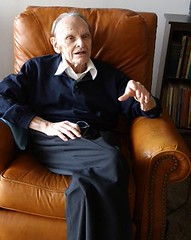 Dr. Coffee fell a while back, but is now hurting so badly that he went back into the hospital this past weekend. The current diagnosis is broken ribs. The hospital is looking to see what else might be broken. He has been in such pain that he could no longer work on the February Fare Box.
Dr. Coffee fell a while back, but is now hurting so badly that he went back into the hospital this past weekend. The current diagnosis is broken ribs. The hospital is looking to see what else might be broken. He has been in such pain that he could no longer work on the February Fare Box.
Keith Baron (Fare Box mailing expert) and (AVA President) Bob Schneider are going to Boston this coming weekend to meet with Dr. Coffee and see what they can do to put out the February Fare Box.
David adds:
John Coffee is about the last living charter member of the American Vecturist Association (transportation token collectors organization formed in 1948) and has been editor of our monthly newsletter since way before my time, never missing an issue. It's not an exaggeration to say that John is the AVA.
He is the author of the Atwood-Coffee Catalog of United States and Canadian Transportation Tokens, published by the Catalog Committee of AVA, of which Dr. Coffee is chairman. It is now in its fifth edition, which came out in 1996, with annual supplements. This work started out as the National Check and Premium List of all U. S. Transportation Tokens, compiled by the late Roland C. Atwood and published in loose leaf format by "the American Numismatic Company" of Los Angeles in 1948, with at least one supplement the following year.
AVA took it over in 1963 and published a hardcover second edition, calling it Atwood's Catalogue. By this time Atwood was AVA life member #1. The third edition, now 731 pages, came out in 1970, followed by a 244-page 1977 supplement. The fourth edition, published in 1983, expanded to three volumes and received its present title. Volume 1 was the regular catalog listing, volume 2 the history and encyclopedia of transportation tokens, and volume 3 a listing of minor die varieties, >2200 pages in all. The fifth edition superseded volume 1 of the fourth edition; the other two volumes have not been updated. See Davis 59 and 44. Dr. Coffee is also the author of Land Company and Real Estate Tokens published by AVA in 1991, and co-author with Harold V. Ford of Automobile Washing Tokens published by AVA in 1986.
For more information about the American Vecturist Association, see: www.vecturist.com

APRIL FOOLS 2012
Last week's April Fool's item caught a lot of people off guard, but most managed to get the joke. Here are some of the reader comments.
Donn Pearlman writes:
Funny stuff, but you realize, of course, that some percentage of your readers will actually think the "ANA Executive Director" story is factual and not realize it is contained in The E-Sylum edition of April first.......
Phil Iversen writes:
Has the ANA board been smoking medicinal marijuana in their closed door board meetings?
I had to write back "April Fool!", and Phil responded, "You got me good this time! Let's hope that others did not take it as seriously as I did. " Alan Weinberg said he and Harvey Stack also swallowed the bait, but most of the readers I heard from were amused - even lawyers!
David Ganz writes:
Two hours after I read it, it occurred to me that April 1st got me. Nice job!
Another reader writes:
Good joke! You almost had me there!
Bob Neale writes:
Hmmm. Dated 1 April. Look forward to next year's announcement! Hope you had fun.
Don Erlenkotter writes:
Bruce MacNall as the new ANA Executive Director?? Unbelievable! We know him all too well out here in Los Angeles. Oh, then I noticed the date of your issue giving this announcement. April Fool!!
At least one person at ANA headquarters got the joke - this was posted on their Facebook page Monday:
Ha ha ha ha. Very funny little April Fool's joke you played on us there, e-sylum
Kerry Wetterstrom replied:
What, and here I was getting ready to send Bruce a congratulations letter!
Kerry adds:
Nice April Fool's joke on Bruce McNall's (correct spelling!) selection as the new ANA Executive Director. Hey, you're right, he's not a lawyer!
The misspelling of McNall's name was one of the clues to the dicey nature of the article. But his "I haven't felt stigmatized by my past yet" quote is real. That together with the fact that he wrote a book about the experiences that landed him in jail led me to believe McNall would be a good sport about it. He's paid his debt to society and that chapter is behind him.
Be sure to check out his book - it's well written and an interesting read with a lot of numismatic connections as well as background on his ownership of the Los Angeles Kings hockey team. "Fun While it Lasted: My Rise and Fall in the Land of Fame and Fortune".
Craig Eberhart writes:
Can we count on Wayne Gretzky manning the front desk and signing autographs?
Dan Demeo writes:
I've known Bruce for maybe 35 years, and had some very pleasant experiences. I never went to Numismatic Fine Arts without stopping to see his mother, Shirley, who ran the book department. Bruce just has this way of getting people excited about something; they lose all sensibilities, and before you know it, he's financing this and that, and this again.
NBS Vice President Marc C. Ricard writes:
Thanks for the wonderful April Fool's Day surprise! I nearly fell out of my chair, but I then realized that the ANA couldn't possibly repeat the sins of the past. I had a much needed belly laugh, and, as always, many thanks for the terrific job you do with The E-Sylum!
Loren Gatch writes:
For a second I didn't realize that the idea of issuing a "Branson Currency" was an April Fool's joke. However, I wouldn't put it past a meglomaniacal CEO to try.
Richard Branson and Virgin Holidays have reacted to holidaymakers' frustrations over exchange rates and poor value by launching a new currency today.
The 'Branson' will be accepted as legal tender at all Virgin Holidays destinations from April 2nd and can be bought through one of the company's 100 retail outlets in the UK as well as in resorts upon arrival. The 'Branson' launch follows research commissioned by Virgin Holidays and think tank Gray HL Division which found poor exchange rates polled highest in reasons for not traveling to a holiday hotspot, followed by bad weather, having to take vaccinations and deadly insects.
To read the complete article, see:
Richard Branson and Virgin Holidays launch new Branson currency
(www.virgin.com/travel/news/richard-branson-and-virgin
-holidays-launch-new-currency-1)
This item from Scott Barman's Coin Collector's Blog describes a change in the composition of U.S. coins. Well thought-out! -Editor
In a rare Sunday announcement, Secretary of the Treasury Tim Geithner announced that beginning in 2013, the U.S. Mint will change the size and composition of U.S. coinage in an effort to the government additional money.
Beginning in 2013, all coins struck by the U.S. Mint will be made of a inox (stainless steel) and will have its diameter reduced in size by 25-percent. The thickness of the coins will not change.
For colored coins, the one-cent coin will be plated with copper to maintain its traditional color. For the dollar coins, the inox planchettes will be treated with titanium nitride (TiN) to add hardness to the coin and give it a golden color. Titanium will be used as a coating on the silver-colored coins.
To read the complete article, see: Treasury Overhauls Circulating Coins (coinsblog.blogspot.com/2012/04/treasury-overhauls-circulating-coins.html)
Ya gotta like this one about a salvage from a vessel mired in about two feet of water. -Editor
Early this morning, Coronado's Bruce Johnson was able to recover roughly $410,00 in silver slot-machine coins from the S.S. Monte Carlo from it's partially, sand-submerged position on Coronado Beach near the Coronado Shores. Yes, you read that correctly, $410,000 in silver coins from a ship that has been beached for over 75 years - completely out in the open. A combination of heavy winter storms, extremely low tides and a Florida-based scavenger service proved to be a perfect storm for one very pleased Coronado local.
Bruce said, "Being born here in Coronado, I grew up listening to stories about all the rumored loot that was trapped inside the Monte Carlo after it sank back in 1936. About two years ago, I made contact with a Florida Keys scavenger crew and we planned the 'attack'. Once we were able to pinpoint the strongest 'metal/silver signal' using a customized LOL (Low Oceanic Locator), it was as easy as cracking a concrete egg!".
To read the complete article, see:
Lifetime Local Bruce Johnson Finds $410,000 in Silver Coins from S.S. Monte Carlo Wreckage
(http://www.ecoronado.com/profiles/blogs/lifetime-local
-bruce-johnson-finds-410-000-in-silver-04012012715)
To read the earlier E-Sylum article, see: ANA TO NAME NEW EXECUTIVE DIRECTOR (www.coinbooks.org/esylum_v15n14a06.html)
ELECTROTYPE PORTRAIT IDENTIFICATIONS
Regarding Christopher Eimer's question about the identification of the portrait on a bronzed electrotype, Andrew Pollock writes:
Here's another portrait (watercolor), three-quarters view. This image was from an earlier edition of The E-Sylum.

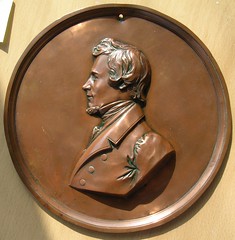
Christopher Eimer writes:
My thanks to Messrs Alexander, Pollack and Travis for their suggestions as to the identity of the large electrotype portrait, which provided a consensus in favour of Jefferson Davis.
A number of facial characteristics, such as the distinctive nose, high cheekbones, firmness of chin and style of hair, not to mention the distinctive form of beard, do indeed point to Jefferson Davis, and a more youthful portrait, as David Alexander suggested. The sitter looks to be somewhere in his forties, or at a stretch early fifties, placing the manufacture of the electrotype no later than the mid-1850s.
One cannot be absolutely certain about the portrait being that of Davis, but the many different images of the man provide the luxury of comparison and on which those distinctive characteristics appear to be common denominators. Furthermore, for someone whose portrait was widely reproduced, and in different media, it is no surprise that a new or different image of the man should come to light; as indeed occurs from time to time with those of the Duke of Wellington (1769-1852).
The ascendancy of Jefferson Davis coincides with the development of the electrotype portrait - as indeed it does with another new medium, the daguerreotype - with the invention of electroplating seemingly attributed to various people and nationalities. Whatever the truth of the matter, this electrotype portrait (which has a diameter of 240 mm. and a depth of 25 mm.) demonstrates considerable technical skill and leads one to think that other such portraits by the same, as-yet unknown, hand might exist, and on which some clue as to artist, manufactory or location might emerge.


To read the earlier E-Sylum article, see: 19TH CENTURY U.S. PORTRAIT IDENTIFICATIONS PROPOSED (www.coinbooks.org/esylum_v15n14a10.html)
QUERY: AGING A PERSON'S PHOTO TO HELP WITH ATTRIBUTION


There were a couple of votes last week for a younger Jefferson Davis in response to the unknown 19th Century electro portrait submitted by Christopher Eimer which it may or may not be... but this past week I received my own lesson in Davisology, albeit on the other end of the age spectrum (which may be of tangential interest to the discussion).
Last week on eBay I listed an early sepia celluloid pinback commemorating the Mississippi Division Confederate Reunion held in Jackson, Miss. in 1903 that I acquired in a major Mississippi - Louisiana collection that I purchased ten years ago. The pin featured an unidentified picture of an aging man that I did not recognize. Thinking locally, I searched all of the CSA generals that I could find that 1) commanded the Mississippi Division or commanded a unit that served in Mississippi, or 2) was native of Mississippi, and 3) survived the war to grow old enough (which greatly narrowed the field). The only somewhat close match to me was Braxton Bragg whom I offered as a potential candidate but I also asked to be enlightened if anyone knew.
The South immediately rose again and informed me (in force) that the image is the last known photo of Jefferson Davis, circa 1898 or so which was also the year of his death. In 1903 his wife Winnie donated their home named Beauvior to the Sons Of Confederate Veterans to be used as a home for elderly CSA soldiers.
Every police procedural show on television has an expert that can construct or computerize an image of a person to show what they would look like 15 - 30 - 45 years later in life... possibly we could hire one of those many experts to do a reversal on the images we have of an older Prexie Jefferson Davis to see if we come up with Chris Eimer's electro bust?
MORE ON THE SMITHSONIAN'S LINCOLN MEDAL
Regarding Dick Doty's question about a medal in the National Numismatic Collection at the Smithsonian, NBS president Dan Freidus writes:
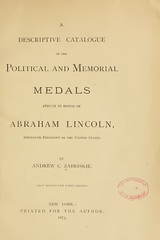 This may not really help Dick in his hunt to identify the Lincoln medal illustrated in last week's E-Sylum, but might be a useful hint for other researchers. When faced with a case like this, where I know there is an old reference in the field that might be online, I find an online search is often quicker than using my own library.
This may not really help Dick in his hunt to identify the Lincoln medal illustrated in last week's E-Sylum, but might be a useful hint for other researchers. When faced with a case like this, where I know there is an old reference in the field that might be online, I find an online search is often quicker than using my own library.
In this case, I knew of Zabriskie's work on Lincoln medals so I found an online version using Google. Archive.org is the site I chose to use since they often have multiple file formats. In this case, they have an online version with both page images and searchable text.
A quick search for "hand" or "1863" suggests it's not listed in Zabriskie (which is what I expected). But this all took under a minute while scanning the entire 28 pages of text on paper would have taken longer even if the book was already sitting on my desk. Here's the link: archive.org/details/descriptivecatal00zabr .


Ed Hohertz writes:
Could the medal have come from the Robert Hewitt Jr. collection?
From Wikipedia, the free encyclopedia
Robert Hewitt, Jr. was a successful real estate investor in Manhattan, New York, and a notable numismatist. Hewitt began collecting coins as a young man while serving a mercantile apprenticeship and compiled a comprehensive Abraham Lincoln medal collection considered by numismatists as one of the greatest of its kind. In 1908, Hewitt produced a medal to commemorate the centennial birth of Abraham Lincoln. Hewitt commissioned sculptor Jules Edouard Roiné of Paris for the design and the medal "offered a stinking frontal bust in high relief."
In 1918, Mrs. Hewitt donated the Robert Hewitt Lincoln collection to the U.S. National Museum (Smithsonian Institution). At the time of donation, the U.S. National Museum reported that the collection included "1,200 specimens of medallic souvenirs of President Lincoln, and includes medallions, plaques, medals, medalets, coins, tokens, and…campaign" items.[6] Hewitt's extensive collection of Lincolniana provided both an important historical and artistic view of Lincoln.
In addition, Hewitt founded the important numismatic group the Circle of Friends of the Medallion in 1909 with other medal enthusiasts and produced the first privately created medal series in America. Also, Hewitt served as the Corresponding Secretary of the American Numismatic and Archaeological Society (currently the American Numismatic Society) in 1868-69 and the Second Vice President in 1880-84.
Dick Doty writes:
Thanks for the idea, but both specimens were labeled FIC - found in collection, which is our polite way of saying we have no idea where they came from!
Ed Hohertz continues:
This medal was reported in 'Lincoln in Numismatics' in the Numismatist by Robert P. King and reprinted by the Token and Medal Society in 1966. Unfortunately, no date is given for the casting of the medal. The original articles ran in 1924, 1927 and 1933.
#228. Obv., On a plain field a clothed, bearded bust of Lincoln facing right. Rev., An open hand is extended, showing broken shackles; above, in large figures, the date, "1863". Symbolic of the negro race, made free by the Proclamation of Emancipation signed January 1, 1863. Copper (cast). Size 82 mm.
It is not listed by the 1863 date in the Biographical Dictionary of Medalists.
Dick Doty adds:
Thanks! Thing is, we wanted to use it in an upcoming book of Civil War-related objects, but if it's nowhere near the date it bears (and I don't think it is), then it can't be included. Pity; it's dramatic.
To read the earlier E-Sylum article, see: QUERY: LINCOLN MEDAL ORIGIN SOUGHT (www.coinbooks.org/esylum_v15n14a16.html)
MORE ON THE PROPOSED U.S MINT AT THE DALLES, OREGON

1849 $5 Oregon Beaver gold coin (image from CoinFacts.com)
R. S. Neale writes:
I must have missed the earlier issue, or just didn't notice your query about the Dalles (almost) mint. It was one of the places considered by folks who responded to the question, which ran a few months ago, of how many places were authorized to mint coins for the US. None of last week's responses appear to mention the following, which does bear on the numismatic connection and which I include below for further information.
The Oregon provisional legislature authorized an 'Oregon Mint' on 16 Feb 1849. It was to be in Oregon City, and missioned to coin $2M from gold dust brought back from California. But Oregon was voted into the Union as a Territory, and the new territorial governor ruled in March that the Oregon Mint would be contrary to the US Constitution, which prohibits the states from coining money.
So the 'Oregon Exchange Company' was formed privately in 1849 near Portland and in 1849 (only) issued some 6000 (combined, I believe) $5 and $10 gold pieces known as 'beaver money.'
It wasn't until 1864 that the US Congress authorized a mint, to be sited at The Dalles. It was begun in 1868 as a 2-story building, 75-ft square. However, the gold flow dried up rapidly in the late 1860s, and the completion of the trans-America Railway at Promontory Point 10 May 1869 linked the coasts and convinced the US government that Denver would be a better central location than The Dalles. As of 1870, only the basement and first floor of the now abandoned 'mint' had been completed. The building was sold to private interests, who added the second floor. As of 2004, the building was in use - as a storage facility for cell phones.
Dave Bowers adds:
There is an extensive discussion of the mint at The Dalles in my Treasure Ship S.S. Brother Jonathan book.
To read the earlier E-Sylum article, see: THE PROPOSED U.S MINT AT THE DALLES, OREGON (www.coinbooks.org/esylum_v15n14a08.html)
COLONEL GREEN AND THE INVERTED JENNY
Dave Hirt writes:
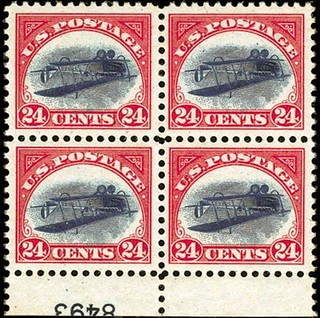 I'm glad you put in that piece on the Frelinghuysen stamp collection. Concerning the 1918 Inverted Jenny stamp, there in an interesting account of it in the book The Day They Shook The Plum Tree by Arthur B. Lewis. If any of our readers have this book in their library, it can be found on pages 245 & 246.
I'm glad you put in that piece on the Frelinghuysen stamp collection. Concerning the 1918 Inverted Jenny stamp, there in an interesting account of it in the book The Day They Shook The Plum Tree by Arthur B. Lewis. If any of our readers have this book in their library, it can be found on pages 245 & 246.
Colonel E.H.R."Ned" Green purchased a sheet of them for $20,000 (a lot of money in those days)! He was constantly besieged by kings, maharajas, princes, and multimillionaires to sell some of them. Finally about 1930, he broke up the sheet, keeping the prime positions, including the center line block for himself. He numbered each stamp on the back, so that the buyer would know the exact position of the stamp on the sheet. The individual stamps sold as the book states, "so fast it would take your breath away". The nearest thing to this in numismatics that I can think of would be the 1955 double date cent.
To read the complete article, see: FRELINGHUYSEN STAMP COLLECTION BRINGS RARITIES TO MARKET (www.coinbooks.org/esylum_v15n14a18.html)
MORE ON THE SCHULMAN MEDALLIC HISTORY OF MONEY AND BANKING
Dick Johnson writes:
The Schulman series was struck by Medallic Art Company in 1971. I cataloged only five of the 12 medals struck. The intent was to have an obverse by one sculptor, and reverse by another (always a bad choice when creating any fine art medal). However, numbers 1, 2, 9 and 10 (Babylonian Market, Croesus, Ben Franklin, David Rittenhouse) were modeled by sculptor Patrick Whitaker, and all reverses by Ramon Gordils. Whitaker could not meet the demand for other medals so these were assigned to hand engravers (uniformity of series just went out the door).
To read the earlier E-Sylum article, see: QUERY: SCHULMAN MEDALLIC HISTORY OF MONEY AND BANKING (www.coinbooks.org/esylum_v15n14a15.html)
2012 MEMPHIS INTERNATIONAL PAPER MONEY SHOW SPEAKERS
The speakers series for the 2012 Memphis International Paper Money Show to be held June 8-10 has shaped up to be particularly strong this year with a diverse range of topics so there is something for everyone.
- Official Counterfeiting by Joseph E. Boling
- Paper Money of Palestine and Israel by Carlton Chambliss
- Currencies of North Viet Nam during the American War by Howard Daniel & Roger Urce
- Short Snorters and Other Numismatic Souvenirs of WWII by Ray and Steve Feller
- Inside the Treasury - National Bank Notes from Behind the Scenes by Lee Lofthus
- $5 Series of 1882 Brown Back Title Block Layouts by Peter Huntoon
- State and Territorial Seal Varieties on the Backs of Series 1875 and 1882 Nationals by Peter Huntoon & Andrew Shiva
- The New National Bank Note Census - Hickman/Kelly/Gengerke/Huntoon rolled into one by Andrew Shiva, National Currency Foundation
- Series of 1929 Replacement Notes by James Simek
- 19th Century Counterfeit Currency Detection and Prevention Literature by Michael Sullivan
- The Birth of Confederate Paper Money by Wendell Wolka
- The Complete Story of the $1 Legal Tender 1928 Red Seals by Jamie Yakes
ANA MUSEUM SHOWCASE IN DENVER FEATURES AUDIO TOURS
ANA Museum Showcase in Denver to Feature Amazing Rarities
Exhibits explore Lesher Dollars, 1792 Half Disme and more
The American Numismatic Association's signature Museum Showcase, featuring rare and historically significant numismatic treasures, will be on display at the 2012 Spring National Money Show, May 10-12 in Denver.
The showcase includes rarities from the ANA's Edward C. Rochette Money Museum and exclusive private collections. Located on the bourse floor at the Colorado Convention Center in Denver, the showcase will feature informative, museum-quality exhibits with audio tours. Several rarities will make their Showcase debut in Denver, including the 1792 Half Disme.
"The Museum Showcase is an unparalleled feature of ANA shows and provides visitors with an educational and entertaining view of spectacular numismatic objects," ANA President Tom Hallenbeck said. "We are able to present these treasures because of our wonderful collection and the generosity of our members."
Most exhibits will be accompanied by Money Talks, the ANA's cell phone-guided audio tours, which are written and narrated by some of the country's most knowledgeable authors and experts. Go to www.NationalMoneyShow.com/museum-showcase to listen to podcasts of these tours as they are released.
Following is a list of Museum Showcase exhibits to be displayed in Denver. The ANA is also completing arrangements for exhibits on Indian Peace Medals, Colorado territorial gold and Colorado gold nuggets.
The 1792 Half Disme
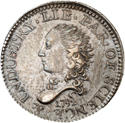
An estimated 1,500 half disme silver coins were struck in the basement of a saw-maker's shop in Philadelphia in 1792 because the U.S. Mint was not yet operational. The coins - slightly smaller than a modern dime and weighing half as much - were first authorized by President Washington under the Mint Act of 1792. Thomas Jefferson, who was then serving as secretary of state, personally received the coins on Washington's behalf.
Modern researchers estimate that about 275 of the 1,500 originally struck survive today. The coin on display in the showcase was donated to the Money Museum in January by Steven L. Contursi, president of Rare Coin Wholesalers of Irvine, Calif.
Lesher Referendum Dollars
 Seldom-seen, oddly shaped Lesher Dollars are interesting, rare pieces of money in Colorado's history. These octagonal silver "coins" were privately issued by Joseph Lesher in Victor, Colo., in 1900 and 1901 to boost local commerce and support silver mining. Various merchants punched their names into the coins, which was a form of advertisement and a message that Lesher dollars could be used to trade for goods and services at said business.
Seldom-seen, oddly shaped Lesher Dollars are interesting, rare pieces of money in Colorado's history. These octagonal silver "coins" were privately issued by Joseph Lesher in Victor, Colo., in 1900 and 1901 to boost local commerce and support silver mining. Various merchants punched their names into the coins, which was a form of advertisement and a message that Lesher dollars could be used to trade for goods and services at said business.
It's not clear how many Lesher dollars were actually struck — Lesher himself said in a 1914 interview that between 3,000-3,500 were minted, but noted Lesher Dollar researcher Adna Wilde believed only about 1,870 were made, of which only 550 were documented at the time.
Money Talks audio tour: Token dealer and Lesher Dollar collector Chris Marchase tells the story of Joseph Lesher's unusual dollars. Call 719-325-7608 and press 5#.
The Idler/Bebee Class III Specimen 1804 Dollar
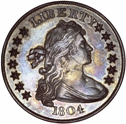 Known as "The King of U.S. Coins," the 1804 dollar is extremely rare, with only 15 known examples. No U.S. dollars dated 1804 actually were struck in that year; Class I specimens were struck in 1834-5 as diplomatic gifts (8 known), while Class II (unique) and III specimens (6 known) were struck during the 1850s for collectors. The Idler/Bebee specimen was donated to the ANA by Aubrey and Adeline Bebee in 1991.
Known as "The King of U.S. Coins," the 1804 dollar is extremely rare, with only 15 known examples. No U.S. dollars dated 1804 actually were struck in that year; Class I specimens were struck in 1834-5 as diplomatic gifts (8 known), while Class II (unique) and III specimens (6 known) were struck during the 1850s for collectors. The Idler/Bebee specimen was donated to the ANA by Aubrey and Adeline Bebee in 1991.
Money Talks audio tour: Kenneth E. Bressett, who co-authored "The Fantastic 1804 Dollar" with Eric Newman, discusses the lore, origins and history behind the 1804 Dollar. Call 719-325-7608 and press 1#.
The McDermott/Bebee Specimen 1913 Liberty Head "V" Nickel
Five Liberty Head nickels were made in 1913 under mysterious circumstances. The existence of the nickels was unknown until 1919, when an advertisement in The Numismatist offered to purchase any example for $500. The ad was placed by Samuel W. Brown, a former Mint employee. In 1920 Brown exhibited all five nickels at the ANA convention in Chicago. The McDermott/Bebee specimen was donated to the ANA by Aubrey and Adeline Bebee in 1989.
Money Talks audio tour: NGC Chairman Mark Salzberg has authenticated all five 1913 Liberty Head Nickels and has many insights on these coins. Call 719-325-7608 and press 2#.
To listen to the audio, see: Museum Showcase (www.nationalmoneyshow.com/museum-showcase)

WOMEN AT THE U.S MINT AND BEP
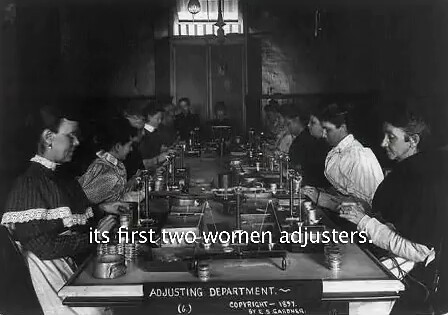
Adjusters in the 1890s
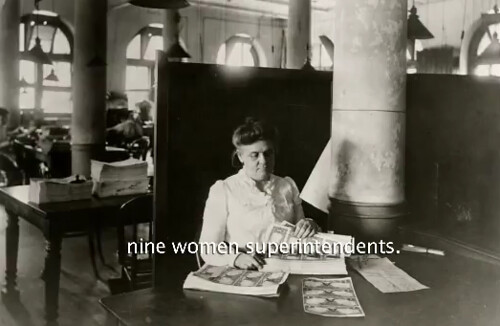
A woman inspector at work at the Bureau of Engraving and Printing
To view the complete video, see: Women Making History at the United States Mint & Bureau of Engraving and Printing (www.youtube.com/watch?v=quEBnKpTVmg&feature=youtube_gdata)
NOTES FROM E-SYLUM READERS: APRIL 8, 2012
Bowers Pens History of Silent Movies
Regarding my comment that our move from plain text to HTML was like "stepping into the Technicolor Land of Oz from the dreary black-and-white past", Dave Bowers writes:
Hey! Black and white past is not dreary. The 750-page manuscript by me and co-author Dr. Kathryn Fuller, 1000 NIGHTS AT THE MOVIES, a comprehensive history of silent movies 1895-1915, is now in the hands of Whitman and will be published this year. All about black-and-white movies!!!
To read the earlier E-Sylum article, see: THE E-SYLUM : HOW MANY ISSUES? (www.coinbooks.org/esylum_v15n14a02.html)
Corrections
Joe Levine writes:
You have quoted me no less than three times in the last issue. I have absolutely no recollection of writing any of these three statements. Am I getting senile - or have you confused me with someone else?
The jury's still out on Joe's senility, but mine is plainly creeping in - these were all in an email response from Joe BOLING. We've fixed our back issue archive. Sorry!
"The Dalles had an almost-US branch mint - construction started, never finished, and authority withdrawn."
"I'll take a WAG and say that Twain and Harte were likely to be found in Calaveras County."
"In regard to Hank Spangenberger's 1876 wood medals, a substantial collection of them was exhibited at the ANA's National Money Show in Ft Worth..."
Another mistake in the issue was that I'd linked Henry Scott Goodman's ad to his 'museum site' (karlgoetz.com) and not the correct sales site which is karlgoetzmedals.com. We also fixed this in the archive and the ad is rerunning in this issue. Sorry!
7 Questions on Defunct Coins
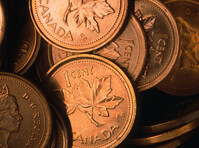 Dick Hanscom forwarded this link to a BBC News quiz inspired by the impending demise of the Canadian cent:
7 questions on defunct coins
(www.bbc.co.uk/news/magazine-17613742)
Dick Hanscom forwarded this link to a BBC News quiz inspired by the impending demise of the Canadian cent:
7 questions on defunct coins
(www.bbc.co.uk/news/magazine-17613742)
Who can get all seven right? Dick got 5, but admits to guessing on two of his correct answers. I only managed to get 2!
Civics 101 Test
Here's a non-numismatic quiz forwarded by Dave Bowers. I did much better on this one - 90%! Dave notes that "super-impressively, Dennis Tucker is far in the front with just 1 wrong!!!"
Are you more knowledgeable than the average citizen? The average score for all 2,508 Americans taking the following test was 49%; college educators scored 55%. Can you do better? Questions were drawn from past ISI surveys, as well as other nationally recognized exams.
Full Civic Literacy Exam (from our 2008 survey) (www.isi.org/quiz.aspx?q=FE5C3B47-9675-41E0-9CF3-072BB31E2692)
1940 Census Records Released
I can't believe we missed this in The E-Sylum last week - the 1940 census is opening up this week. Census records are sealed for 72 years. It was notable when the 1930 one opened in 2002, but this one will be searched and analyzed even more quickly with the latest technology. Here's the link: www.archives.gov/research/census/1940/ .
The site was inundated with user requests when it opened. As of yesterday morning this note was posted there:
We apologize for the problems you have encountered with the 1940 census web site and share your frustration. We have seen extraordinary demand for the 1940 census records, with over 37 million hits since 9:00 a.m. on 4/2/12.
We are making updates to the 1940 census website to better accommodate users and expect to see improved performance over the next several hours. While these changes take place, you can still use many of the useful features built into the website (search for enumeration districts, bookmark results, etc).
Where to Find El Sitio No. 2 Online
Horacio Morero writes:
The Numisma website is on stand-by because Enrique Rubio Santos (Spanish citizen), the owner of the site, passed away in February 2012. It is really bad news for the numismatic community. We are working on a website of our own, but in the meantime you can view the two numbers of The Sitio in this website: www.numisnati.com/2012/04/el-sitio-boletin-numismatico-digital.html
To read the earlier E-Sylum article, see: URUGUAYAN NUMISMATIC PUBLICATION EL SITIO NO. 2 AVAILABLE (www.coinbooks.org/esylum_v15n14a05.html)
Richard Crosby Remembers Hank Spangenberger
Richard Crosby of Pittsburgh, PA writes:
I first met Hank in the late 1960s at the Penn Ohio show at the Webster Hall Hotel in Oakland (a section of Pittsburgh). This was the same hotel that hosted the 1935 ANA convention in Pittsburgh. Hank always had many interesting items on display in his cases and some were also available for sale. He always willing to share his knowledge in any medals or tokens he had of willing to help identify any that I had.
I remember buying from him a set of wooden medals from the 1876 Centennial, Encased medals from the 1893 Columbian Expo and much later on a very large collection of 1907 Hudson Fulton Celebration medals. He also sold me many of the early ANA Convention badges. If you were looking for interesting Exonumia, Hank was the person to go to. He also conducted several mail auctions. Fortunately I still have those catalogues. He was such an fine person and will be missed by all.
Exactly When Will Canada Stop Producing the Cent?
The big news last week was Canada's decision to stop producing their cent. Regarding Coin World's headline "Canada to Stop Producing Cent in the Fall", Dick Johnson writes:
I believe the headline in Coin World's April 16th issue (next week) is incorrect. That Canada will stop production of the cents in the Fall. That is how I interpreted it when I first read the releases.
But deeper reading was the statement they would stop production in April, not the Fall. Makes sense, not to strike cents for four or five more months when they know the coins will not be used.
It is the Royal Canadian Mint's distribution of the cents that will probably run out by Fall. This is how I wrote my item for The E-Sylum last Sunday. I hope this is accurate and that Coin World got it wrong. Let's wait and see.
Coin World Article on PHX Bux
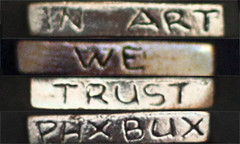 A reader pointed out that there was an article by Jeff Starck in Coin World about the Phoenix "PHX BUX" coins. Thanks! I couldn't locate an individual web page, but the article can be found in the archives of complete issues. See the July 27, 2009 issue, page 5: "'Discount Art Tokens' circulating in Phoenix' Art District".
A reader pointed out that there was an article by Jeff Starck in Coin World about the Phoenix "PHX BUX" coins. Thanks! I couldn't locate an individual web page, but the article can be found in the archives of complete issues. See the July 27, 2009 issue, page 5: "'Discount Art Tokens' circulating in Phoenix' Art District".
To read the earlier E-Sylum article, see: ARTICLE HIGHLIGHTS PHOENIX "PHX BUX" COINS (www.coinbooks.org/esylum_v15n14a20.html)
THE COLORADO SPRINGS COIN CLUB 50TH ANNIVERSARY MEDAL
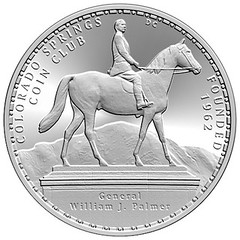

This year marks the semi-centennial of the Colorado Springs Coin Club. The club was established in 1962 and has promoted numismatics in the Pikes Peak region since its inception. Over the years its membership has included many nationally prominent numismatists among who are Adna G. Wilde Jr., Al C. Overton, Edward C. Rochette, Kenneth E. Bressett, Kenneth L. Hallenbeck, Robert W. Hoge, Steven J. D'Ippolito, Thomas Hallenbeck, William C. Henderson and many others.
To celebrate this event the Colorado Springs Coin Club commissioned noted coin designer and medalist Daniel Carr and his Moonlight Mint to design and strike their 50th Anniversary Commemorative Medal.
Mr. Carr submitted the winning design for the New York and Rhode Island Statehood Quarters while the Maine quarter design used by the United States Mint was based on his concept. World Coin News awarded his Rhode Island quarter design its' 2001 Coin of the Year (COTY) award as the best "Trade" (circulating) Coin in the world. Mr. Carr also submitted designs that reached the finalist stage for the Wisconsin, Florida, California and Colorado quarters as well as for the reverse of the Sacagawea Dollar.
The obverse of the club's medal features an image of the Palmer statue located in downtown Colorado Springs which depicts the founder of the city, General William Jackson Palmer, astride his horse. Placed in the background is a panoramic view of Pikes Peak.
The medal's reverse features the image of a gold coin based on the 1861 Clark, Gruber and Company "Pikes Peak" Liberty Head design bearing the fantasy date of 1862 which is 100 years prior to the founding of the club.
Satin finish medals are expected to be available for distribution by the end of April with proof-like medals available in the mid to late June timeframe.
SCREW ALASKA WITH WOODEN RADICALS
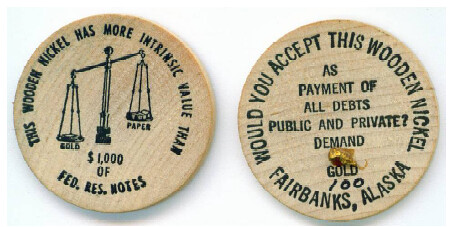
Ever wonder what your editor was doing in 1976? Through a fortunate purchase, we can show you! About 1976 (I can't remember the exact date), I issued the wooden nickel above. It compared the intrinsic value of the wood to Federal Reserve notes. I don't know how many were made, but my guess is 200. Of that number, 100 had a gold nugget attached and were serially numbered.
 1979 marked the 20th anniversary of Alaska statehood.
This was the time of the native land claims,
the antiquity act, national monuments and D-2, which
locked up massive amounts of public land in Alaska.
1979 marked the 20th anniversary of Alaska statehood.
This was the time of the native land claims,
the antiquity act, national monuments and D-2, which
locked up massive amounts of public land in Alaska.
I thought it appropriate that a suitable commemorative
should be issued, hence the Alaska Statehood
Commemorative Kit. You got a large wooden token
and a screw. Just follow the directions.
GILROY ROBERTS EXHIBIT TO OPEN AT THIRD PHILADELPHIA MINT
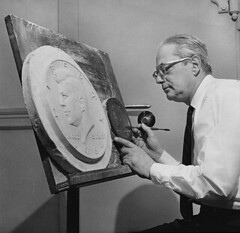 A replication of former U.S. Mint Chief Engraver Gilroy Roberts' artist's studio has found a permanent home for public exhibit at the Community College of Philadelphia in a structure that once served as the third Philadelphia Mint.
A replication of former U.S. Mint Chief Engraver Gilroy Roberts' artist's studio has found a permanent home for public exhibit at the Community College of Philadelphia in a structure that once served as the third Philadelphia Mint.
The exhibit is being developed as an outgrowth of the pledge of a $1.02 million donation from the Gilroy and Lillian P. Roberts Charitable Foundation to further educational outreach at the college.
The gift represents the largest single private donation in the school's 46-year history.
The donation will be used to exhibit and preserve items from the personal collection of Gilroy Roberts, the ninth chief engraver of the U.S. Mint. Roberts served in the presidentially appointed chief engraver's post from 1948 to 1964.
Officials at the college are hoping that the Roberts exhibit — planned for a circular hallway within the 1700 Spring Garden St. building's rotunda — can be ready by late fall. However, officials suggested the process could be accelerated after learning from Coin World March 28 of the American Numismatic Association World's Fair of Money to be held Aug. 7 through 11 at the Pennsylvania Convention Center in Philadelphia. That would allow the college to showcase the exhibit during the ANA show.
The Spring Garden Street structure that served as the third Philadelphia Mint is located just over a mile away from the convention center and the ANA's 225,000-square-foot bourse.
Until the formal preparation and installation of the Roberts exhibit, Murphy said, "the collection is being stored right in the Mint Building. As you may imagine, there are many VERY secure places in the building from the days when coins were minted in precious metals."
The Roberts Collection includes many of Gilroy Roberts' sculpturing tools, including some homemade items; plaster models and galvanos for coins and medals, including some of the coins and medals produced; sculptures and paintings; materials used for design inspiration; coin and medal drawings; photos of the third Philadelphia Mint from its days as a functional production facility; and even an engine used for engine-turned engraving, Murphy said.
In addition to displaying Roberts' personal items, the exhibit is also being designed to include educational interactive components.
Since the college's acquisition of the Mint Building in 1971, the facility's rotunda has primarily been used for receptions and art exhibitions.
To read the complete article, see: Gilroy Roberts exhibit to open at third Philadelphia Mint (www.coinworld.com/articles/gilroy-roberts-exhibit-to-open-at-third-phila/)
THE BOOK BAZARRE
RECONSTITUTING THE EAST INDIA COMPANY
Joe Boling writes:
The East India Company coins are referred to as legal tender, but nowhere in the article or anyplace else I look is that status justified. Legal tender, where, for what?
Philip Mernick asks a similar question. He writes:
The question I ask is legal tender WHERE? The East India Company was dissolved under the 1874 Government of India Act so how come there were shares available to be bought by this entrepreneur?
Mehta spent a considerable amount of time, money and effort traveling around the world visiting museums, former EIC trading etc. He also read all the records of East India Company and met people who had a fair knowledge of business of the time when company was established.
East India Company - Owning a Company that Once Owned Us
(www.indiamarks.com/guide/East-India-Company-Owning-a
-Company-that-Once-Owned-Us/18183/)
EIC was acquired from 33 different shareholders by Mehta, an Indian entrepreneur, in 2005. Over the next five years, over £20 million was pumped into the company to rebuild and position EIC as a luxury brand. The East India Company was relaunched on August 15, 2010 with its first flagship 'Fine Food' store in Conduit Street, London. On December 24 the same year, the Mahindra Group acquired a minority stake in the Company.
To read the complete article, see: East India Company mints mohur, cash again (articles.timesofindia.indiatimes.com/2012-03-29/kolkata/31254350_1_eic-coinage-act-royal-mint)
An E-Sylum readers points out:
The revival of the EIC brand and the issuance of its new coins was the subject of a cover story in the February issue of Coin World's World Coins (Feb. 6, 2012 issue).
The story reports that Royal Mint engraver Claire Aldridge worked on the plasters; whether she designed the coins or whether the designs came from the EIC officials was not reported.
To read the earlier E-Sylum article, see: A REVIVED EAST INDIA COMPANY STRIKES COINS (www.coinbooks.org/esylum_v15n14a23.html)
PINEDA COLLECTION OF PHILIPPINE COINS AND PAPER MONEY
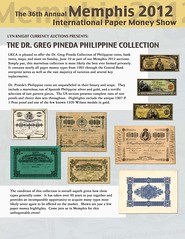 As some have already seen elsewhere, Lyn Knight is going to be offering what I consider to be the best collection of Philippine coins and paper money that has ever been assembled. This signal event will take place at the Memphis show on Sunday, June 10. A special catalog is being prepared just for this sale, and it should take a good portion of that day to get through it. This marvelous collection was formed over about 40 years by a Bakersfield CA neurologist, Dr. Greg Pineda, whom I have known for most of that time. In fact, he asked that I do a lot of the write-ups and that's exactly what I am in the midst of right now.
As some have already seen elsewhere, Lyn Knight is going to be offering what I consider to be the best collection of Philippine coins and paper money that has ever been assembled. This signal event will take place at the Memphis show on Sunday, June 10. A special catalog is being prepared just for this sale, and it should take a good portion of that day to get through it. This marvelous collection was formed over about 40 years by a Bakersfield CA neurologist, Dr. Greg Pineda, whom I have known for most of that time. In fact, he asked that I do a lot of the write-ups and that's exactly what I am in the midst of right now.
I feel that Gramsters should like to know more about this spectacular Philippine sale because there are most definitely some items that should be of special interest to them. Among those are the Treasury Certificates dated 1936 and 1941 that were requested by the War Department during WWII. Some of these are very scarce now, and one in particular is among the rarest of them all. It's the 10 pesos dated 1941 that was tumbled around with floor sweepings and assorted dirt to make it resemble a circulated note. A limited number of 1, 5 and 10 pesos were thus treated; while the 1 peso is occasionally found, I know of but a single 5 pesos and only two examples of the 10, both in low grade as would be expected. Pineda's is the better of the two and it will be offered in the sale.
Another area of more than passing interest is Pineda's coverage of the VICTORY issues and those same notes with the Central Bank overprint added to the backs. This collection has ALL the signature varieties of the very tough 100 and 500 pesos notes, no small feat even many years ago as they just were not saved. Who cold afford to put away a 500-peso note worth $250 US just because it was pretty. Some of these are true rarities with so few known.
In general, Pineda's paper money presents a wonderful array of early Spanish-Philippine notes plus his great coverage of the Silver and Treasury Certificates, Philippine National Bank (complete, including the three overprints of 1919), and Bank of the Philippine Islands also complete.
In coins, there is a fabulous group of counter-stamps, high-grade Spanish issues, all the rare proofs of 1903-08, plus a great many Spanish and US issues in extremely choice grades. If you have any interest at all in these series, especially under the US which is so popular today, then this auction is an absolute MUST on your schedule.
For more information on the MPC Gram, contact: MPCGram@yahoo.com
THE ROYAL CANADIAN MINT MINTCHIP CHALLENGE

John Mutch writes:
I think this is just another facet of the news from Canada about discontinuing the one cent piece.
The Royal Canadian Mint MintChip Challenge invites software developers to create innovative digital payment applications using MintChip, a R&D phase technology available only to challenge participants. Developers and the public are also encouraged to share ideas for how a digital currency can be used.
Winners will receive approximately $50,000 in gold from the Mint as well as promotional exposure. Prizes will be awarded for the apps that best demonstrate the potential value of the MintChip technology and have the greatest potential impact on digital payment technology. Submitted apps can run on Android, BlackBerry, iOS, Windows or desktop and mobile browsers.
The Mint will provide participating developers with a software developement kit (SDK), two microSD MintChips, and two remote MintChip accounts they can use to integrate the Mint's technology with their digital payment applications.
The public and developers have approximately four months to share ideas and build their submissions. A panel of distinguished judges from the tech, venture capital, media, and retailer industries will select winners, and the general public will vote to identify a "Popular Choice" winner.
To learn more about the MintChip Challenge, see: The Royal Canadian Mint is challenging software developers to create apps for MintChip, the evolution of currency. (mintchipchallenge.com)
THE BOOK BAZARRE
THE DEATH OF BOOKS
The Pew Internet and American Life Project says 21% of Americans have read an e-book in the last year as of February. That's up from 17% in December.
It also surveyed Americans to find out what they like about e-books versus print books. The result is below. As you can see, print books are only better for reading with a child, and sharing with friends.
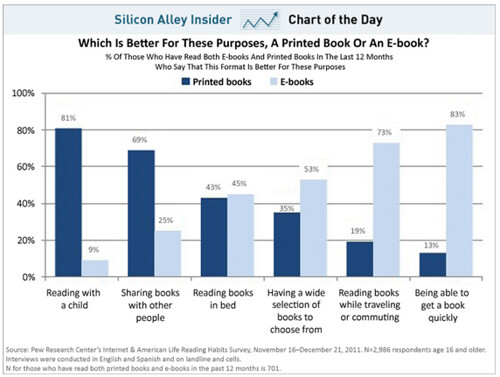
To read the complete article, see: CHART OF THE DAY: The Death Of Printed Books (www.businessinsider.com/chart-of-the-day-e-books-versus-print-books-2012-4)
FEATURED WEB PAGE: QUEEN HANDS OUT MAUNDY MONEY
This week's Featured Web Page is appropriate for this Easter week - it's a newspaper article about Queen Elizabeth II distributing Maundy coinage on Maundy Thursday.
To mark her Diamond Jubilee, the Queen handed out money to people from all of the UK's 44 Christian dioceses.
Usually, the Maundy money is given to people from a single diocese.
But this year, 86 women and 86 men - one for each of the Queen's 86 years - received the money in recognition of their services to the Church and their communities.
The royal party was greeted with rapturous applause and cheering as they emerged on to the steps of the Minster following the hour-long service.
The Dean of York, The Very Reverend Keith Jones, said the Queen had specifically requested that this year's service was a large one reflecting the celebrations for her Diamond Jubilee.
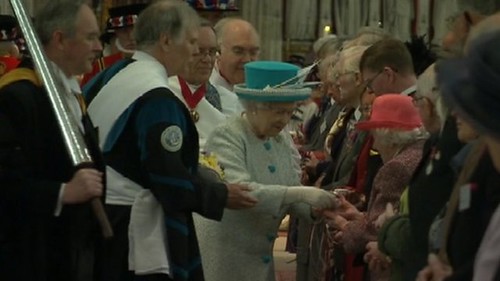
/www.bbc.co.uk/news/uk-england-york-
north-yorkshire-17611227
